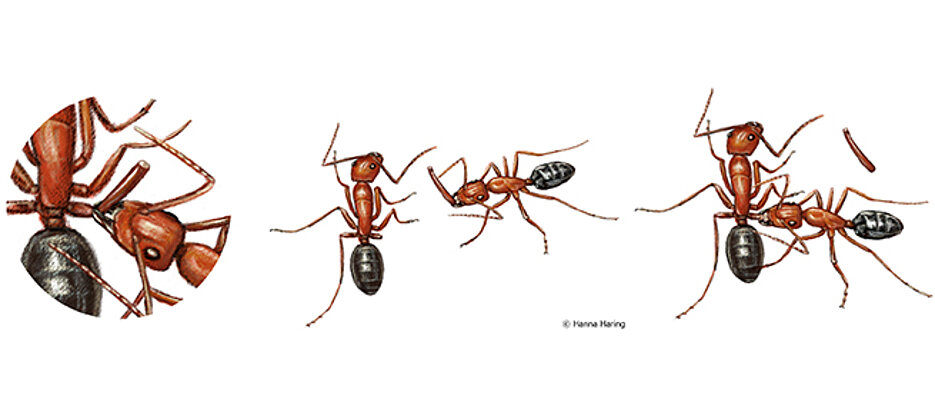In an emergency, ants bite off injured limbs of fellow ants to ensure their survival. Whether they take this radical step depends on the location of the wound.

They exhibit a behaviour that was previously only known in humans: Florida carpenter ants (Camponotus floridanus) amputate limbs as a precautionary measure to save the lives of wounded conspecifics. In the case of certain injuries to the legs, they bite them off completely.
This brutal procedure prevents life-threatening wound infections from spreading through the ants' bodies. The success rate is very good: around 90 per cent of the amputated animals survive the treatment. Despite the loss of one of their six legs, they are then able to resume their full range of tasks in the nest.
Surprising: Amputations are Only Performed on Injured Thighs
Researchers from Julius-Maximilians-Universität (JMU) Würzburg in Bavaria, Germany, and the University of Lausanne in Switzerland report this in the journal Current Biology. The team led by Dr Erik Frank from the JMU Biocentre and Dr Laurent Keller from Lausanne made another astonishing observation: The ants only proceed to amputation if the leg injuries are on the thigh (femur) - regardless of whether the wounds are sterile or infected with bacteria.
If, on the other hand, the wounds are on the lower leg (tibia), they never amputate. Instead, the ants put more effort into caring for the wounded in such cases: They lick the wounds intensively. This is presumably a mechanical way of removing bacteria. This therapy is also relatively successful, with a survival rate of around 75 per cent.
Hopeless: Amputation of Injured Lower Legs
Why don't the ants also remove the legs of conspecifics with lower leg injuries - after all, one could assume that this would significantly increase the survival rate?
To find the answer, the researchers performed amputations themselves on ants with wounded and bacterially infected lower legs. The results were surprising: The survival rate after amputation was only 20 per cent.
The team can plausibly explain why this is the case: Computer tomographic examinations showed that there are many muscles in the ants' thighs whose activity ensures the circulation of the ants' "blood", the haemolymph. Ants do not have a centrally pumping heart like humans, but several heart pumps and muscles distributed throughout the body that fulfil this function.
"Injuries to the thigh impair the muscles and hinder circulation," says Erik Frank. Because the blood flow is reduced, bacteria cannot get from the wound into the body as quickly. In this case, amputation is worthwhile: if action is taken quickly, there is a good chance that the body will still be free of bacteria.
In contrast, there are no muscles in the lower leg that are relevant for the circulation of haemolymph. If it is wounded, the bacteria penetrate the body very quickly. The time window for a successful amputation is then narrow and the chance of rescue is slim.
"This is exactly what the ants seem to 'know', to put it in human terms," says the Würzburg biologist. "Our study proves for the first time that animals also use prophylactic amputations in the course of wound treatment. And it shows that the ants orientate the treatment to the type of injury," says Laurent Keller.
Dangerous: Fights Against Other Ant Colonies
The ant species examined in the study, Camponotus floridanus, is found in the south-east of the USA. The reddish-brown animals are relatively large, measuring up to 1.5 centimetres in length. They nest in rotting wood and defend their home vigorously against rival ant colonies. If fights break out, there is a risk of injury.
Why did the team choose these carpenter ants for the study? Because they do not have a metapleural gland. Other ant species use this gland to produce an antibiotically effective secretion, which they apply to infected wounds. This raised the question of what other agents Camponotus ants use against infections. It was a big surprise to learn that these are injury-specific amputations.
Question: How do Ant Species Native to Germany Act?
Erik Frank will continue to study injuries in ants and their reaction to them. The head of an Emmy Noether Group funded by the German Research Foundation (DFG) is currently preparing a study on this topic on ant species that occur in Germany.
In January 2024, the Hector Fellow Academy honoured Erik Frank with a Hector Research Career Development Award, which includes a fully funded PhD position and 55,000 €, for his work on wound care in animals. "This award will enable my group to further investigate the behaviour of social wound care in animals. We want to use it to find out how ants that live in a close relationship with acacia trees heal the wounds of their host plants."
Publication
Wound-dependent leg amputations to combat infections in an ant society. Erik. T. Frank, Dany Buffat, Joanito Liberti, Lazzat Aibekova, Evan P. Economo, Laurent Keller. Current Biology, 2 July 2024, DOI: 10.1016/j.cub.2024.06.021






